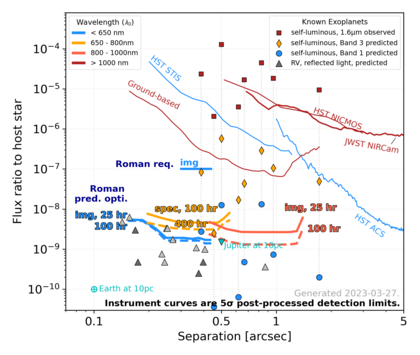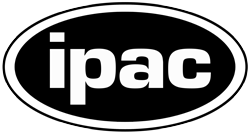Overview
Coronagraph Instrument Observing Scenario 11 (OS11; J. Krist, JPL, 2022) single-roll no-MUF (model uncertainty factor) simulation
The Roman Coronagraph Instrument is an advanced technology demonstrator for future missions that will directly image Earth-like exoplanets. The Coronagraph will premiere in space the technologies needed by future missions to image and characterize rocky planets in the habitable zones of nearby stars. By demonstrating these tools in a system with end-to-end, scientific observing operations, NASA will reduce the cost and risk of a potential future flagship mission. Potential technology demonstration phase observations will include self-luminous and reflected-light planet imaging and spectroscopy, bright debris disk polarimetry, and faint debris disk detection.
The Coronagraph architecture consists of three observing modes --- Direct Imaging narrow, Direct Imaging wide, and Spectroscopy --- implemented with three different sets of masks and filters. These modes share the same optical beam train, with two wavefront control loops to achieve high contrast, i.e., better than 10-8. The fully-supported narrow field-of-view mode imaging ("Band 1") will be implemented via a Hybrid Lyot stop mask, whereas the best-effort-supported R~50 prism spectroscopy ("Band 2" and "Band 3") and wide field-of-view imaging modes ("Band 4") will use a Shaped Pupil mask.

After demonstration of the Level-1 requirement on the Instrument, other observations that could be undertaken include known planets which are self-luminous at visible wavelengths; the potential first-ever images and spectroscopy of a true Jupiter analog in reflected light; low surface brightness debris disks; and, the potential first-ever visible light images of exozodi.
The Coronagraph Community Participation Program (CPP) will work with the Coronagraph Instrument team to plan and execute its technology demonstration high-contrast observations. The principals of each selected investigation, together with the Coronagraph project and international partner representatives, form the basis of the CPP Team.
The Roman Science Support Center at IPAC, working with partners at the Jet Propulsion Laboratory (JPL), is responsible for the Coronagraph Instrument operations, data processing and management, and support for the exoplanet community.
Technical Information
Instrument Reference Information
- Roman Coronagraph Community Participation Program
- Overview of the Coronagraph Instrument Technical Demonstration (PDF)
- Roman Coronagraph Primer (PDF)
- Instrument Parameters
- Coronagraph Instrument Contrast Curves
- Filter Transmission Curves (zip file, 20.8 kB)
- Coronagraph Polarization Fraction Correction
- Roman Coronagraph Instrument Test Results Information Session Held Aug 26-27, 2024
- Roman Coronagraph Information Sessions Held Oct 24, 26, 2021
- Coronagraph Instrument Overall Calibration Plan
- Coronagraph Instrument Flatfield Plan
- Simulation Effects of CTI on Coronagraph Instrument Observations
- Calibrating Detector Backgrounds for the Roman Coronagraph EXCAM Detector
- Calibrating Electron Multiplication Gain for the Roman Coronagraph Detector
Targets and Observing Constraints
- Roman Space Telescope Coronagraph Instrument Exoplanet Characterization
- Exposure Time Calculators
- Coronagraph Target Accessibility
Image Simulations and Data Processing
- Data Analysis Environment Plans from SSC
- Coronagraph Instrument Science Simulations
- Operating Scenario OS11 for HLC
- Observing Scenario (OS) 11 Post-Processing Report
- Nancy Grace Roman Space Telescope Coronagraph Instrument Pupil
- HLC Processing Results
Other Resources
- Coronagraph Community Participation Program AAS 245 Splinter Session Held Jan 14, 2025
- Roman Coronagraph Instrument Test Results Info Session Held Aug 26-27, 2024
- Recent Papers (SPIE Proceedings Vol. 13092, 2024)
- S. Wolff et al. 2024, The Roman coronagraph community participation program: observation planning
- J.J. Wang et al. 2024, The Roman coronagraph instrument: pathways to imaging reflected light planets and habitable worlds
- E. Choquet et al. 2024, ESCAPE Project: investigating active observing strategies and post-processing methods for exoplanet high contrast imaging with future space missions
- Previous Science Investigation Team Repositories
- Roman Coronagraph for Macintosh SIT
- Turnbull SIT 2015-2021 for Turnbull SIT
- Nancy Grace Roman Telescope at JPL
- Nancy Grace Roman Telescope at GSFC
Coronagraph Instrument 3-D Printable CAD Models
The JPL Coronagraph Instrument Team has provided 3D printable STL format files for printing scale models, 1:5 and 1:11, of the Roman Coronagraph Instrument on any desktop or commercial 3D printer. The assembly is printed in several smaller components which can be assembled to create a replica of the coronagraph instrument. Models do not require support material and are in English units.

